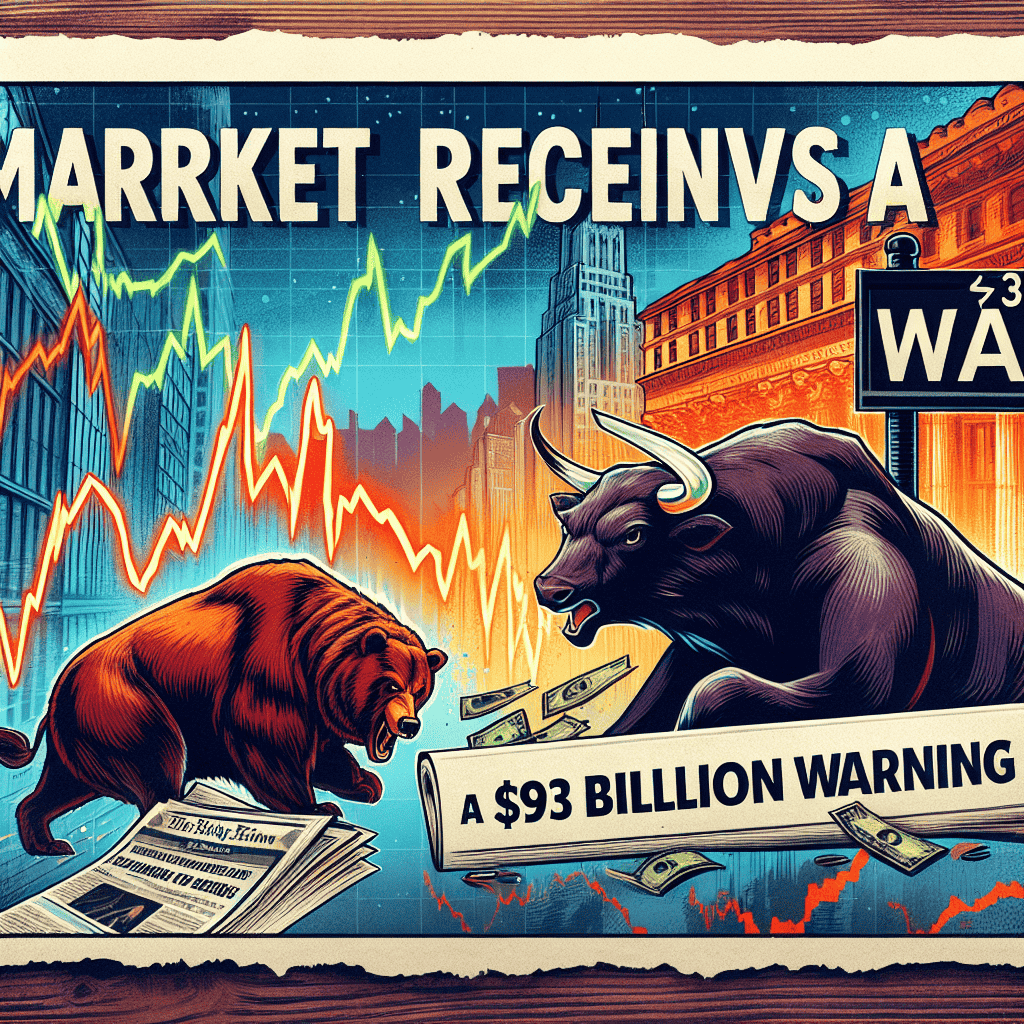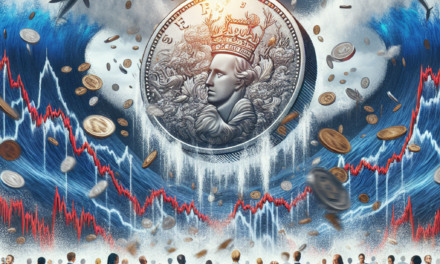“Brace for Impact: Buffett’s Billion-Dollar Signal Foretells Market Turbulence Ahead.”
Introduction
Warren Buffett, the legendary investor and CEO of Berkshire Hathaway, recently issued a stark warning to Wall Street, signaling potential turbulence ahead for the stock market. With a staggering $93 billion in cash reserves, Buffett’s cautious stance suggests he is preparing for significant market volatility or a downturn. Historically, such moves by Buffett have often preceded market corrections or shifts, as his investment strategies are closely watched by investors worldwide. This substantial cash reserve indicates a lack of appealing investment opportunities at current market valuations, hinting at potential overvaluation or economic uncertainty. As history has shown, when Buffett exercises caution, it often foreshadows a period of market adjustment, prompting investors to brace for possible changes in the financial landscape.
Warren Buffett’s $93 Billion Warning: Implications for Wall Street
Warren Buffett, often regarded as one of the most astute investors of our time, has recently sent a significant warning to Wall Street, one that carries a weight of $93 billion. This substantial figure represents the cash reserves held by Berkshire Hathaway, Buffett’s conglomerate, which has been steadily increasing. The accumulation of such a large cash reserve is not merely a reflection of Berkshire’s profitability but also a strategic decision by Buffett, signaling his cautious outlook on the current state of the stock market. Historically, Buffett’s investment decisions have been closely watched by investors and analysts alike, as they often provide insights into broader market trends.
The decision to hold such a large amount of cash suggests that Buffett perceives the stock market as overvalued or fraught with uncertainty. In the past, Buffett has emphasized the importance of having cash on hand to take advantage of market downturns, allowing him to purchase undervalued assets at a discount. This strategy has served him well, particularly during periods of economic turbulence. Therefore, the current accumulation of cash could be interpreted as a preparation for potential market corrections or downturns.
Historically, when Buffett has taken a conservative stance, it has often preceded significant market shifts. For instance, prior to the 2008 financial crisis, Buffett was similarly cautious, and his foresight allowed Berkshire Hathaway to capitalize on the subsequent market recovery. This pattern suggests that Buffett’s current warning should not be taken lightly by investors. While it is impossible to predict the exact timing of market movements, Buffett’s actions imply that he anticipates a period of volatility or correction in the near future.
Moreover, the broader economic context supports Buffett’s cautious approach. The stock market has experienced a prolonged bull run, driven by factors such as low interest rates and substantial fiscal stimulus. However, these conditions are beginning to change. Central banks around the world are signaling tighter monetary policies, and inflationary pressures are mounting. These developments could lead to increased market volatility, as investors adjust to a new economic environment.
In addition to macroeconomic factors, there are also sector-specific concerns that may be influencing Buffett’s decision. The technology sector, which has been a major driver of market gains in recent years, is facing regulatory scrutiny and potential headwinds. Similarly, geopolitical tensions and supply chain disruptions continue to pose risks to global markets. These uncertainties may further justify Buffett’s decision to maintain a significant cash reserve.
While some investors may view Buffett’s warning as a signal to adopt a more defensive investment strategy, others may see it as an opportunity to reassess their portfolios and identify potential areas of risk. Diversification and a focus on quality investments may become increasingly important as market conditions evolve. Additionally, investors may consider maintaining their own cash reserves to take advantage of potential buying opportunities during market corrections.
In conclusion, Warren Buffett’s $93 billion warning serves as a reminder of the importance of prudence and strategic foresight in investing. While the stock market has enjoyed a period of robust growth, history suggests that such growth is often followed by periods of correction or volatility. By heeding Buffett’s warning and preparing for potential market shifts, investors can position themselves to navigate the challenges and opportunities that lie ahead.
Historical Patterns: Stock Market Reactions to Major Warnings
Warren Buffett, often regarded as one of the most astute investors of our time, recently sent a significant warning to Wall Street, amounting to a staggering $93 billion. This move has sparked widespread speculation and concern among investors and analysts alike. To understand the potential implications of Buffett’s actions, it is essential to examine historical patterns and how the stock market has reacted to similar major warnings in the past. By doing so, we can gain insights into what might unfold next in the financial markets.
Historically, when influential figures like Warren Buffett issue warnings or make substantial financial moves, the stock market tends to react in a manner that reflects both caution and anticipation. For instance, during the financial crisis of 2008, Buffett’s strategic investments and warnings were closely watched by investors seeking guidance amidst the turmoil. His actions often serve as a barometer for market sentiment, influencing both individual and institutional investors.
One notable pattern observed in the past is that when Buffett signals caution, the market often experiences increased volatility. This is primarily because investors, aware of Buffett’s track record and investment acumen, tend to reassess their portfolios and strategies. Consequently, this reassessment can lead to fluctuations in stock prices as investors either pull back from riskier assets or seek safer havens. In this context, Buffett’s recent $93 billion warning could potentially trigger a similar wave of volatility, as market participants digest the implications of his actions.
Moreover, historical data suggests that major warnings from influential investors often precede a period of market correction or adjustment. This is not to say that a market crash is imminent, but rather that the market may undergo a phase of recalibration. During such periods, overvalued stocks may see a decline, while undervalued or fundamentally strong companies might attract more attention. This rebalancing act is a natural response to the realization that market exuberance may have outpaced underlying economic fundamentals.
In addition to volatility and potential corrections, another historical pattern worth noting is the eventual stabilization and recovery of the market. While warnings from figures like Buffett can induce short-term uncertainty, they also serve as a catalyst for necessary adjustments that pave the way for long-term growth. Investors who remain patient and adhere to sound investment principles often find opportunities amidst the turbulence. This resilience is a testament to the market’s ability to self-correct and adapt to changing conditions.
Furthermore, it is important to consider the broader economic context in which Buffett’s warning was issued. Factors such as interest rates, inflation, and geopolitical developments can all influence how the market responds to such signals. Historically, when these external factors align with warnings from influential investors, the market’s reaction can be more pronounced. Therefore, keeping an eye on these variables can provide additional insights into the potential trajectory of the stock market.
In conclusion, Warren Buffett’s $93 billion warning to Wall Street is a significant event that warrants careful consideration. By examining historical patterns, we can anticipate that the stock market may experience increased volatility, potential corrections, and eventual stabilization. While the immediate reaction may be one of caution, history suggests that the market’s inherent resilience will ultimately prevail. Investors who remain informed and vigilant can navigate this period of uncertainty with confidence, drawing lessons from the past to guide their future decisions.
Analyzing Warren Buffett’s Investment Strategies in Uncertain Times
Warren Buffett, often revered as one of the most astute investors of our time, has once again captured the attention of Wall Street with a significant move that has left analysts and investors alike pondering the implications. Recently, Buffett’s investment conglomerate, Berkshire Hathaway, reported a staggering $93 billion in cash reserves. This substantial cash pile is not merely a testament to the company’s profitability but also serves as a strategic signal to the market. Historically, Buffett’s accumulation of cash has often preceded periods of market volatility or downturns, suggesting that the Oracle of Omaha is preparing for potential turbulence ahead.
To understand the significance of this move, it is essential to delve into Buffett’s investment philosophy, which is deeply rooted in value investing. Buffett has consistently emphasized the importance of purchasing undervalued stocks with strong fundamentals and holding them for the long term. However, when the market becomes overheated and stock valuations soar beyond their intrinsic value, Buffett tends to exercise caution. By amassing cash, he positions himself to capitalize on opportunities that arise when the market corrects itself, allowing him to acquire quality assets at a discount.
The current economic landscape presents a myriad of challenges and uncertainties, from geopolitical tensions to inflationary pressures and fluctuating interest rates. These factors contribute to an environment where stock prices may not accurately reflect the underlying value of companies. Buffett’s decision to hold onto a substantial cash reserve can be interpreted as a prudent measure to safeguard against potential market corrections. Moreover, it underscores his belief that patience is a virtue in investing, as waiting for the right opportunity can yield significant rewards.
Historically, Buffett’s cash accumulation has often been followed by strategic acquisitions during market downturns. For instance, during the financial crisis of 2008, Berkshire Hathaway made several high-profile investments in companies like Goldman Sachs and General Electric, capitalizing on the distressed market conditions. This pattern suggests that Buffett’s current cash reserve could be a precursor to similar moves should the market experience a downturn.
While some investors may view Buffett’s cash hoard as a bearish signal, it is crucial to recognize that his approach is not driven by short-term market predictions but rather by a long-term perspective. Buffett’s strategy is not about timing the market but about being prepared for opportunities that arise when others are fearful. This mindset aligns with his famous adage: “Be fearful when others are greedy and greedy when others are fearful.”
In conclusion, Warren Buffett’s $93 billion cash reserve serves as a powerful message to Wall Street, highlighting his cautious stance in the face of current market conditions. By analyzing his past actions and investment philosophy, it becomes evident that Buffett is positioning himself to take advantage of potential market corrections. While the future remains uncertain, history suggests that Buffett’s strategic patience and readiness to deploy capital during downturns could lead to significant gains. As investors navigate these uncertain times, they would do well to heed Buffett’s example, focusing on long-term value and maintaining the discipline to act decisively when opportunities present themselves.
The Role of Economic Indicators in Predicting Market Trends

Warren Buffett, often regarded as one of the most astute investors of our time, recently sent a $93 billion warning to Wall Street, prompting analysts and investors alike to scrutinize the potential implications for the stock market. This substantial figure, representing the cash reserves held by Buffett’s Berkshire Hathaway, serves as a significant economic indicator that could foreshadow future market trends. Historically, such actions by influential investors have been closely monitored, as they often provide insights into broader economic conditions and potential market shifts.
Economic indicators play a crucial role in predicting market trends, offering valuable insights into the health and direction of the economy. These indicators, which include metrics such as GDP growth rates, unemployment figures, and consumer confidence indices, help investors make informed decisions. In the context of Buffett’s warning, the accumulation of cash reserves can be interpreted as a signal of caution. When a seasoned investor like Buffett opts to hold substantial cash rather than invest it, it suggests a lack of attractive investment opportunities or an anticipation of market volatility.
Transitioning to historical patterns, it is essential to consider how similar actions have influenced market behavior in the past. During periods of economic uncertainty, investors often seek safe havens, leading to increased cash holdings. This behavior was evident during the 2008 financial crisis when many investors, including Buffett, opted to preserve capital amid market turmoil. Consequently, the stock market experienced significant fluctuations, underscoring the importance of cash as a buffer against economic downturns.
Moreover, the current economic landscape presents several challenges that could justify Buffett’s cautious stance. Rising inflation rates, geopolitical tensions, and concerns over global supply chain disruptions have all contributed to an environment of uncertainty. These factors, combined with the Federal Reserve’s monetary policy adjustments, have heightened market volatility. In such a climate, holding cash provides flexibility and the ability to capitalize on future investment opportunities when market conditions stabilize.
Furthermore, historical data suggests that periods of increased cash holdings by major investors often precede market corrections or downturns. This pattern can be attributed to the fact that large cash reserves indicate a lack of confidence in the market’s immediate prospects. As investors anticipate potential declines, they may choose to divest from riskier assets, leading to downward pressure on stock prices. Consequently, the stock market may experience a correction as investors realign their portfolios in response to perceived risks.
In conclusion, Warren Buffett’s $93 billion warning serves as a poignant reminder of the role economic indicators play in predicting market trends. By analyzing historical patterns and current economic conditions, investors can gain valuable insights into potential market movements. While no single indicator can predict the future with certainty, the accumulation of cash reserves by a prominent investor like Buffett should not be overlooked. As history has shown, such actions often precede significant market shifts, underscoring the importance of vigilance and strategic decision-making in navigating the complexities of the financial landscape. As investors continue to monitor these developments, the interplay between economic indicators and market trends will remain a critical focus in the quest for financial stability and growth.
Lessons from Past Market Corrections and Buffett’s Insights
Warren Buffett, often regarded as one of the most astute investors of our time, has recently sent a significant warning to Wall Street, amounting to a staggering $93 billion. This warning, while not delivered through a direct statement, is evident in the actions of his investment vehicle, Berkshire Hathaway. Historically, Buffett’s moves have been closely scrutinized by investors and analysts alike, as they often provide insights into broader market trends. As we delve into the implications of this warning, it is essential to consider the lessons from past market corrections and how Buffett’s insights might inform future market behavior.
To understand the gravity of Buffett’s warning, one must first examine the context in which it was issued. The $93 billion figure represents the cash reserves that Berkshire Hathaway has accumulated, a sum that has grown significantly over recent years. This accumulation of cash suggests a cautious approach, as Buffett appears to be waiting for more favorable investment opportunities. Historically, such a strategy has often preceded market corrections, as Buffett tends to capitalize on undervalued assets during downturns. Therefore, his current stance may indicate an anticipation of market volatility or overvaluation.
Looking back at past market corrections, a pattern emerges that aligns with Buffett’s current strategy. For instance, during the dot-com bubble of the late 1990s and early 2000s, Buffett famously avoided the tech frenzy, opting instead to hold substantial cash reserves. When the bubble burst, he was well-positioned to acquire valuable assets at discounted prices. Similarly, during the 2008 financial crisis, Buffett’s prudent management of cash reserves allowed him to make strategic investments in companies like Goldman Sachs and General Electric, which ultimately yielded significant returns.
Transitioning to the present, the stock market has experienced a prolonged period of growth, driven by factors such as low interest rates and robust corporate earnings. However, this growth has also led to concerns about overvaluation, with some analysts warning of potential corrections. In this context, Buffett’s $93 billion warning serves as a reminder of the cyclical nature of markets and the importance of maintaining a long-term perspective. His strategy underscores the value of patience and discipline, particularly in times of market exuberance.
Moreover, Buffett’s insights extend beyond mere market timing. His investment philosophy emphasizes the importance of understanding the intrinsic value of assets and investing in companies with strong fundamentals. This approach has consistently proven successful, even during periods of market turbulence. As such, investors would do well to heed Buffett’s warning and consider the underlying value of their investments, rather than being swayed by short-term market fluctuations.
In conclusion, Warren Buffett’s $93 billion warning to Wall Street is a testament to his cautious and calculated approach to investing. By examining past market corrections and Buffett’s strategic responses, investors can glean valuable lessons about the importance of patience, discipline, and a focus on intrinsic value. As history has shown, markets are inherently cyclical, and those who remain vigilant and informed are better equipped to navigate the inevitable ebbs and flows. Thus, while the future of the stock market remains uncertain, Buffett’s insights provide a guiding light for those seeking to make informed investment decisions in an ever-changing financial landscape.
How Investors Can Prepare for Potential Market Shifts
Warren Buffett, often regarded as one of the most astute investors of our time, recently sent a significant signal to Wall Street by amassing a cash reserve of $93 billion. This move has not gone unnoticed, as it suggests a cautious approach towards the current stock market environment. Historically, when Buffett takes such a defensive stance, it often precedes notable shifts in market dynamics. Therefore, investors are left pondering what this could mean for the future and how they should prepare for potential market shifts.
To understand the implications of Buffett’s actions, it is essential to consider the historical context. Buffett’s investment philosophy has always been rooted in value investing, which emphasizes the importance of intrinsic value and margin of safety. When he accumulates cash, it typically indicates a lack of attractive investment opportunities at reasonable prices. This behavior has often been a precursor to market corrections or downturns, as it suggests that stocks may be overvalued.
In light of this, investors should consider adopting a more cautious approach to their portfolios. One strategy is to reassess asset allocations, ensuring a balanced mix of equities, bonds, and other asset classes. Diversification remains a key principle in mitigating risk, as it can help cushion the impact of market volatility. By spreading investments across different sectors and geographies, investors can reduce their exposure to any single market downturn.
Moreover, it is prudent for investors to focus on quality investments. This means prioritizing companies with strong fundamentals, such as robust cash flows, low debt levels, and a history of consistent earnings growth. These companies are generally better positioned to weather economic uncertainties and maintain their value over the long term. Additionally, dividend-paying stocks can provide a steady income stream, which can be particularly valuable during periods of market turbulence.
Another important consideration is maintaining a long-term perspective. While short-term market fluctuations can be unsettling, history has shown that markets tend to recover over time. Investors who remain patient and avoid making impulsive decisions based on short-term market movements are often rewarded in the long run. It is crucial to stay focused on long-term financial goals and not be swayed by temporary market noise.
Furthermore, investors should consider building a cash reserve of their own. Having liquidity on hand provides flexibility and the ability to take advantage of buying opportunities when valuations become more attractive. This approach aligns with Buffett’s strategy of waiting for the right moment to deploy capital, rather than rushing into investments when prices are high.
In conclusion, Warren Buffett’s recent actions serve as a reminder of the importance of vigilance and prudence in investing. While it is impossible to predict the exact timing or magnitude of market shifts, history suggests that being prepared can make a significant difference. By reassessing asset allocations, focusing on quality investments, maintaining a long-term perspective, and building a cash reserve, investors can better navigate potential market shifts. As always, staying informed and disciplined in investment decisions will be key to achieving financial success in an ever-changing market landscape.
The Influence of Major Investors on Market Sentiment and Behavior
Warren Buffett, often regarded as one of the most astute investors of our time, has recently sent a significant signal to Wall Street, one that has not gone unnoticed by market analysts and investors alike. With a staggering $93 billion in cash reserves, Buffett’s Berkshire Hathaway has chosen to hold back from making substantial investments, a move that many interpret as a warning about the current state of the stock market. This decision, while seemingly cautious, is deeply rooted in Buffett’s investment philosophy, which emphasizes value and long-term growth over short-term gains. Historically, when Buffett exercises such restraint, it often precedes a period of market correction or volatility, suggesting that the stock market may be poised for a downturn.
The influence of major investors like Buffett on market sentiment cannot be overstated. When a figure of his stature makes a strategic decision, it sends ripples through the financial world, prompting both institutional and individual investors to reassess their positions. This is not merely due to Buffett’s financial acumen but also because of his track record of navigating market cycles with remarkable foresight. Consequently, his actions serve as a barometer for market conditions, providing insights that are often corroborated by subsequent market behavior.
Historically, Buffett’s cautious approach has been a precursor to significant market events. For instance, during the dot-com bubble of the late 1990s, Buffett famously refrained from investing in technology stocks, a decision that was initially criticized but ultimately vindicated when the bubble burst. Similarly, in the lead-up to the 2008 financial crisis, Berkshire Hathaway’s conservative investment strategy shielded it from the worst of the market collapse. These examples underscore the importance of paying attention to Buffett’s investment decisions, as they often reflect underlying market vulnerabilities that may not be immediately apparent.
Moreover, the current economic landscape presents several challenges that could justify Buffett’s cautious stance. Rising interest rates, geopolitical tensions, and concerns about inflation are all factors that contribute to market uncertainty. In such an environment, holding substantial cash reserves provides the flexibility to capitalize on opportunities that may arise from market dislocations. This strategy aligns with Buffett’s belief in being “fearful when others are greedy and greedy when others are fearful,” a mantra that has guided his investment decisions for decades.
As investors digest Buffett’s $93 billion warning, it is crucial to consider the broader implications for the stock market. While it is impossible to predict with certainty what the market will do next, historical patterns suggest that periods of caution from major investors often precede corrections or increased volatility. This does not necessarily mean that a market crash is imminent, but it does highlight the need for vigilance and a reassessment of risk exposure.
In conclusion, Warren Buffett’s decision to amass significant cash reserves serves as a potent reminder of the influence major investors wield over market sentiment and behavior. By examining historical precedents and current economic conditions, investors can gain valuable insights into potential market trajectories. As always, maintaining a balanced and informed approach to investing is essential, particularly in times of uncertainty. While the future of the stock market remains uncertain, the lessons from Buffett’s actions provide a valuable framework for navigating the complexities of the financial landscape.
Q&A
1. **Question:** What is the significance of Warren Buffett’s $93 billion warning to Wall Street?
– **Answer:** Warren Buffett’s $93 billion warning signifies a cautious approach towards the stock market, suggesting potential overvaluation or economic uncertainty.
2. **Question:** How does Warren Buffett typically signal caution in the stock market?
– **Answer:** Warren Buffett often signals caution by accumulating cash reserves, reducing investments, or selling off certain stocks, indicating a lack of attractive investment opportunities.
3. **Question:** What historical pattern is associated with Buffett’s warnings?
– **Answer:** Historically, Buffett’s warnings have often preceded market corrections or downturns, as his cautious approach reflects underlying market vulnerabilities.
4. **Question:** How might the stock market react following Buffett’s warning?
– **Answer:** Following Buffett’s warning, the stock market might experience increased volatility, corrections, or a shift towards more conservative investment strategies by other investors.
5. **Question:** What factors could contribute to Buffett’s decision to issue a warning?
– **Answer:** Factors could include high market valuations, economic indicators suggesting a slowdown, geopolitical tensions, or changes in fiscal and monetary policies.
6. **Question:** How do investors typically respond to Buffett’s market warnings?
– **Answer:** Investors often respond by reassessing their portfolios, increasing cash holdings, or shifting towards safer, value-oriented investments.
7. **Question:** What lessons can be learned from Buffett’s historical market warnings?
– **Answer:** Lessons include the importance of maintaining a long-term perspective, being cautious during periods of market exuberance, and the value of having cash reserves to capitalize on future opportunities.
Conclusion
Warren Buffett’s warning to Wall Street, highlighted by a $93 billion cash reserve, suggests caution in the stock market. Historically, when Buffett has accumulated significant cash, it often precedes market corrections or downturns. This pattern indicates that the stock market may face increased volatility or a potential decline in the near future, as Buffett’s actions often reflect a strategic anticipation of overvaluation or economic uncertainty. Investors might consider this a signal to reassess their portfolios and prepare for possible market adjustments.





